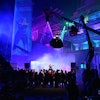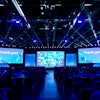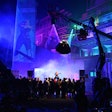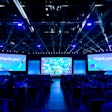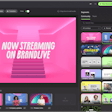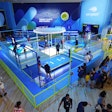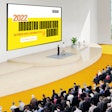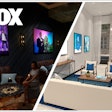As the event industry begins to slowly reopen, it's easy to get lost in the excitement and put all our virtual knowledge learned last year to the side—but don't! With hybrid events expected to be the trend this year, virtual attendees aren't going anywhere. Looking for some inspiration on how to build out an equally engaging experience for your online guests as you are for in-person eventgoers? Keep scrolling for a few tech-forward ideas from brands like Apartment Therapy, Create & Cultivate, Walmart and more.
Apartment Therapy's Small/Cool Experience At Home
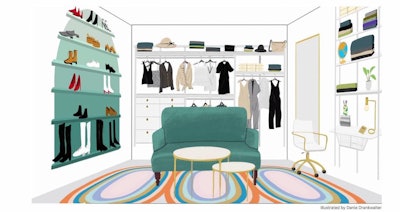
Apartment Therapy's Small/Cool Experience At Home, which took place last spring, was made accessible to attendees from the comfort of their couches with a robust slate of programming and virtual rooms that were explorable online. The shoppable event was originally slated to be held in Brooklyn's Industry City, but the home design and decor site decided to pivot to a virtual experience. It showcased 20 spaces that were created by interior designers and stylists—like this storage-savvy “cloffice” (a closet-office) designed by Jamie and Fillip Hord with Danielle Blundell, pictured here—as playful graphic illustrations on the Apartment Therapy website. For this year's event, the brand is kicking things off with the Small/Cool Contest in partnership with Behr Paint Company. Voting opened April 5, and winners are being announced on a weekly basis by category. See more: How Apartment Therapy Used Instagram Metrics to Program Its Virtual Event
Photo: Courtesy of Apartment Therapy
Create & Cultivate's Money Moves Summit

For its first-ever virtual conference last May, Create & Cultivate traded in hand-held microphones and onstage interviews for Zoom-based fireside chats and online workshops. A modern medley of prerecorded and livestreamed videos accumulated to nearly 10 hours of financial workshops, virtual activations, celebrity keynote speakers (think famed comedian Chelsea Handler, actress-turned-entrepreneur Shay Mitchell and Queer Eye's Bobby Berk), live mentor sessions, roundtable conversations and even a live performance from indie-pop artist Lennon Stella. Pictured here, the C&C team tapped influencer Camille Styles to lead a vision board-making and goal-setting session to engage attendees between panel discussions. See more: See How Create & Cultivate Tackled an All-Day Virtual Conference
Screenshot: Courtesy of BizBash
Morningstar Investment Conference 2020
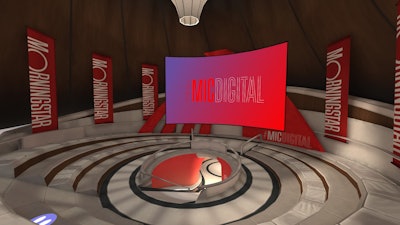
U.K.-based tech company Mesmerise launched GatheringsVR—a new platform that builds immersive, virtual reality-powered worlds for online events—at the 2020 Morningstar Investment Conference in September. The platform was created to combat one of the biggest challenges facing virtual events and conferences: at-home distractions. The event’s 6,000 guests could pay $149 for a traditional ticket, which allowed them to view sessions on a virtual platform from Intrado. Or, they could pay $699 for the enhanced VR experience. Each VR attendee was mailed a sleek, branded package housing a wireless Oculus Quest headset and controllers. During the event, they were transported to a serene outdoor world filled with greenery and eye-catching Morningstar-branded banners. Twenty live and on-demand speaker presentations were streamed on a large screen in a central auditorium area (pictured here), and various VR-fueled exhibition booths and sponsor activations came from the likes of PGIM Investments, Fidelity and PIMCO. See more: See How This Financial Conference Was Brought to Life With Virtual Reality
Photo: Courtesy of Mesmerise
Love Sweat Fitness's Virtual Wellness Festival
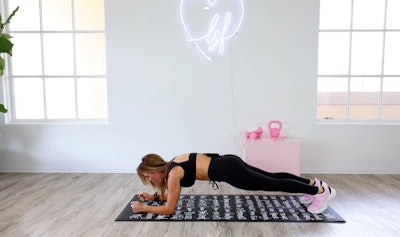
Worried about producing your virtual event without prerecorded content? Love Sweat Fitness founder Katie Dunlop pulled it off for a three-day virtual health and wellness festival held last spring. "You'd be surprised how smooth it can run and operate," she said. Featuring a mixture of yoga and meditation sessions, HIIT workouts, mental health-focused panels, cooking demonstrations and, of course, happy hours and DJ-led dance parties, the weekend-long virtual event flaunted a festival-esque lineup of 24 fitness- and wellness-focused instructors and drew nearly 7,000 attendees—not to mention it was planned in two weeks. The key to hosting a livestreamed event, according to Dunlop, is preparation. "Our team put a lot of work into ensuring that we could have a continuous live experience without technical errors. This can obviously be challenging when you have people coming on and off the stream," she said. "We had to evaluate the best streaming partner that would allow for us to pull this off and brief everyone involved on what we needed from them to ensure everything was smooth. We also focused on building a daily schedule that felt full but also was very intentional in terms of which classes or panels came up in which order. We knew that having back-to-back HIIT workouts wouldn't make sense. It was our hope that those attending could feel comfortable joining us for as many sessions as possible, which took some work to lay it out correctly. [During the event], we had waiting music and slides in between sessions to share who was coming up next, so that when people were attending there wasn't just dead time." See more: Why This Virtual Wellness Festival Went 100-Percent Live
Photo: Courtesy of Love Sweat Fitness
The Lost Corvettes 3D Virtual Auto Showcase
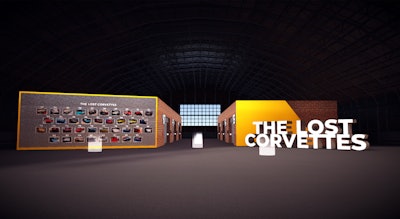
Auto enthusiasts and collectors would have gathered in Detroit for the 2020 North American International Auto Show—but, like all large in-person events in 2020, it was canceled. To fill the void left by postponed and canceled IRL car shows and auctions, a group called the Corvette Heroes decided to launch a 3D virtual auto show to showcase “The Lost Corvettes”: a collection of 36 Corvettes from 1953 to 1989 that is often referred to as the Peter Max Collection. (The pop artist had plans to use them as canvases for a series of paintings, but that project never materialized.) With the help of DKC News’ HangarFour Creative, the Corvette Heroes created a digitally accessible “showroom” where the 36 cars are on display. The look of the virtual garage (shown here), a military-style hangar, was inspired by the National Guard Educational Foundation, the nonprofit beneficiary of the auto show’s promotional giveaway. Inside, virtual visitors could browse details of the cars’ exteriors, as well as get behind the wheel and virtually start the car to hear just what the engine sounds like. Plus, “drivers” could even turn on the radio and play a hit tune from the year the car was made. See more: See How This Corvette Auto Show Hit the (Virtual) Road
Photo: Courtesy of HangarFour Creative
Algenist's At-Home Product Launch
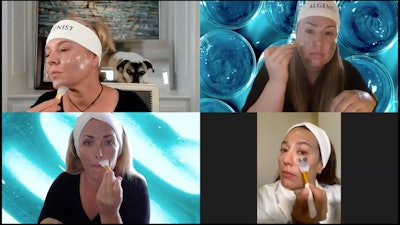
Beauty and skincare brands are at a bit of a disadvantage when it comes to showcasing a product launch online. Since product launches usually involve a lot of hands-on, touchy-feely, IRL interaction, it’s hard to translate that experience into a virtual event. So in order to launch its newest product last summer, the Blue Algae Vitamin C Dark Spot Correcting Peel, Algenist hosted an hourlong virtual masterclass via Zoom. The at-home facial event aimed to give attendees a crash course on the product’s innovative ingredient—blue algae vitamin C, which is pure L-ascorbic acid derived from spirulina—as well as allow them to try the peel first-hand while in-person facial appointments aren't an option. Shannon Shapiro, executive director of marketing for Algenist, explained that “you can’t really understand the full impact [of the peel] until you experience it. So we wanted to actively participate in that experience live and share with our community, which wholeheartedly geeks out on ingredients and formulas. We weren’t going to let a little social distancing stop us from this collective experience. We just had to get a little bit creative with how we executed it.” See more: Why This Skincare Brand Hosted a Product Launch Event Featuring Virtual At-Home Facials
Photo: Courtesy of Algenist
The RAMMY Awards Gala 2020
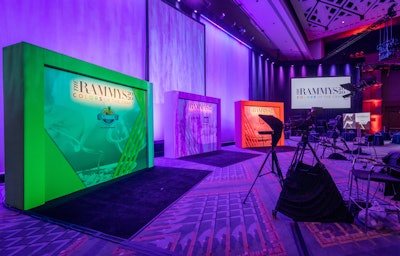
As virtual and hybrid events become widespread, many event and meeting hosts are opting for more advanced production values, gathering small camera crews and presenters in dedicated studios or other venues. And that's exactly what the RAMMY Awards Gala did last year when it shifted to virtual. Produced by RJ Whyte Event Production, the gala—which honors Washington, D.C.'s restaurant and food-service community—was filmed and broadcast virtually last fall. A colorful set reflected the event's diversity-focused Colors of the Craft theme. For the event, presenters were asked to stand on one mark while winners stood 6 feet away on their own mark. Two cameras were used to shoot close-up shots that captured reactions and introductions, while one of the cameras could pull back and shoot a wide shot to show their interactions. “By using a few different camera shots, you can keep presenters safely apart but produce segments that do not look awkward,” event producer Roger Whyte explained. “We also have utilized split-screen technology to show head-on shots of two presenters. This way you can see the conversation between the two and keep them at a safe distance—they could even be in separate locations.” See more: 6 Stage Design Tips for Livestreamed Events
Photo: Courtesy of RJ Whyte Event Production
#AExMEProm
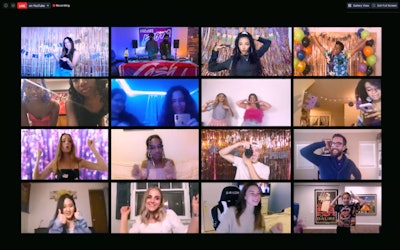
When the pandemic canceled high school seniors' last-ever proms across the nation, clothing brand American Eagle worked with SHADOW to host an all-out online gathering. The so-called #AExMEProm—which drew 17,500 attendees—place on Zoom and was simultaneously streamed on YouTube to allow for more attendees. Performers included social-media personality Addison Easterling, who taught attendees a new TikTok dance; singer-songwriter Tinashe, who performed three songs; and DJs Cash Cash, who spun throughout the hourlong event. Perhaps the biggest challenge for virtual events? Making attendees feel engaged, invested and involved—from home. American Eagle did this by having the host ask questions to the crowd through Zoom's chat function and facilitating giveaways of AE products throughout the night. The brand also invited a select group of VIPs to join Zoom as "panelists" rather than "attendees." At various times throughout the event, organizers would turn on that group's cameras to show off their at-home prom setups and TikTok-inspired dance moves. See more: See How Brands Are Using Virtual Proms to Engage Gen Z
Photo: Derrek Harris
Walmart's U.S. Holiday Meeting 2020
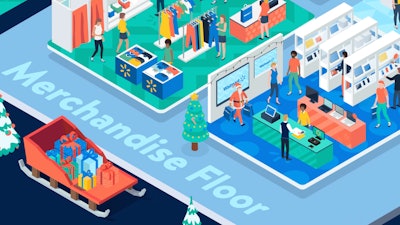
Walmart’s annual holiday meeting serves a few different purposes: It’s a chance for the brand’s U.S. store leadership to preview new merchandise and make plans for the season, of course—but it’s also a place to share best practices, recognize key accomplishments and create a sense of camaraderie and team bonding. And in 2020, those goals felt more crucial than ever. “It was important, especially virtually, to create a sense of community and share appreciation,” explained Jenifer Bice, Walmart’s senior director of event solutions. Walmart's event solutions team worked with event agency INVNT, who built, designed and managed what they call a “unique world within a world” experience. Attendees could participate in real time through interactive chats, games and Q&As, and there was a mix of both live and prerecorded messages from Walmart executives. Prerecorded video was also used for the virtual “merchandise floor” (pictured here), which was segmented by product type and filled with “booths” that could be clicked on to get more information. See more: 5 Clever Ways Walmart Kept Employees Engaged During a Two-Day Virtual Meeting
Photo: Courtesy of Walmart
Untethered Virtual Conference

Welcoming more than 4,400 event professionals over three days, last spring's Untethered conference was founded and produced by Allie Magyar, CEO of event management company Hubb. Its purpose? To provide a space for meeting and event planners to learn and experiment on a virtual platform. “It was a safe space to try new things,” said Magyar. Education sessions dealt with the fallout from COVID-19, touching on topics like revenue, sponsorships and event design. One-on-one appointments were created for attendees to gain guidance on myriad subjects. Presentations were created using multiple tools, including Zoom, WebX, Vimeo and a custom streaming service. Even Hubb’s platform, designed to look like the interior of a convention center, was an example of presenting a new way for planners to develop virtual events. Registration was free with the option to donate a nominal amount to the Meetings Industry Fund, which provides relief and support to event professionals in crisis. See more: How This Virtual Summit Reached Over 4,000 Event Professionals
Photo: Courtesy of Hubb
